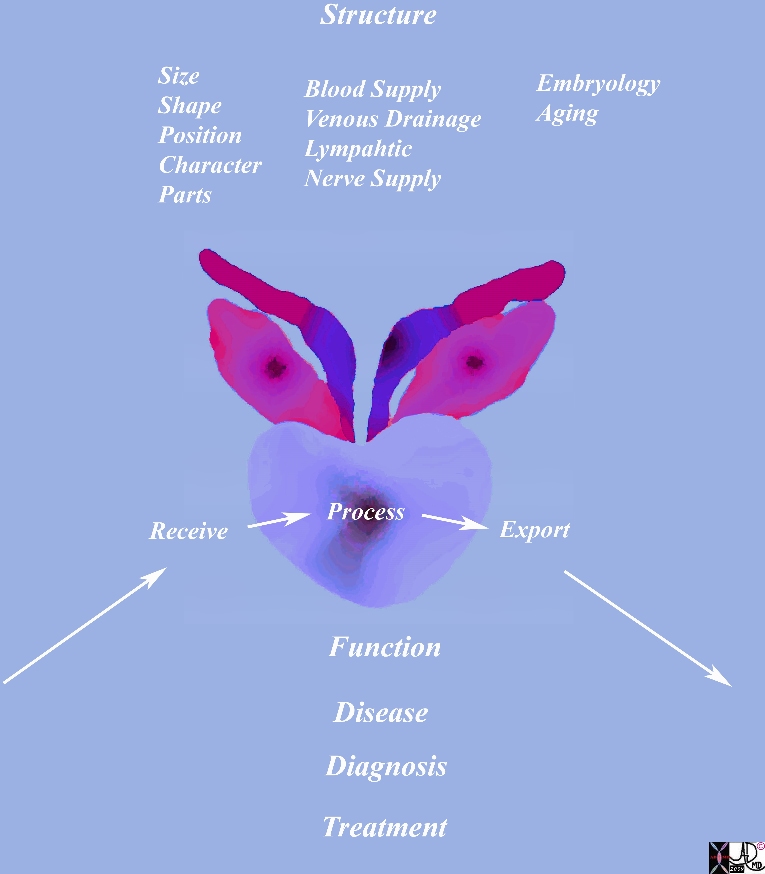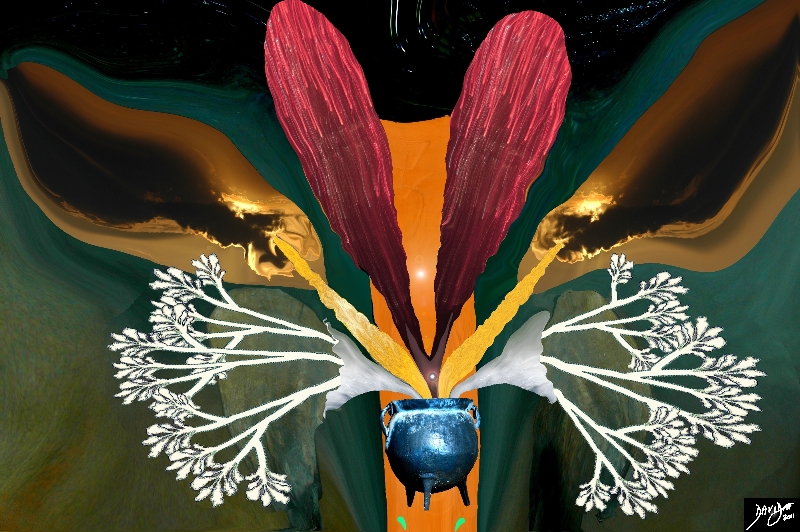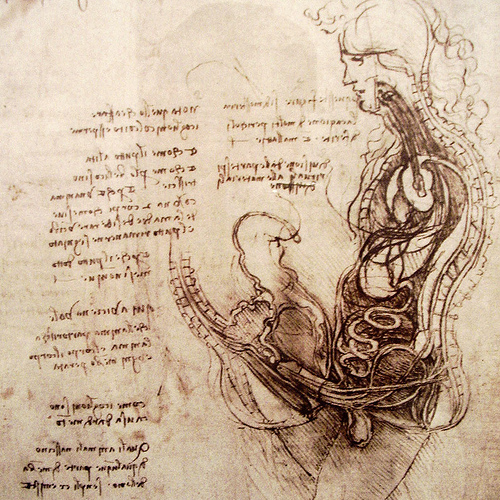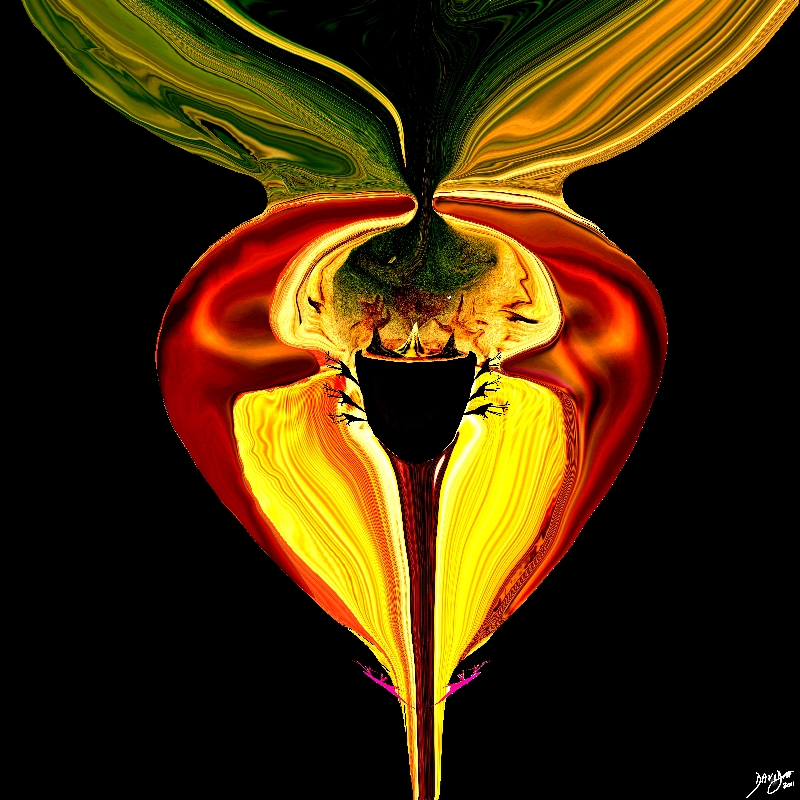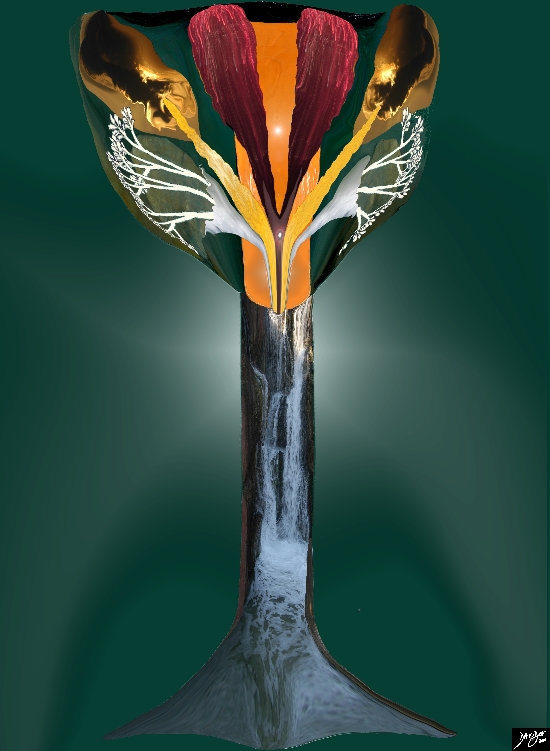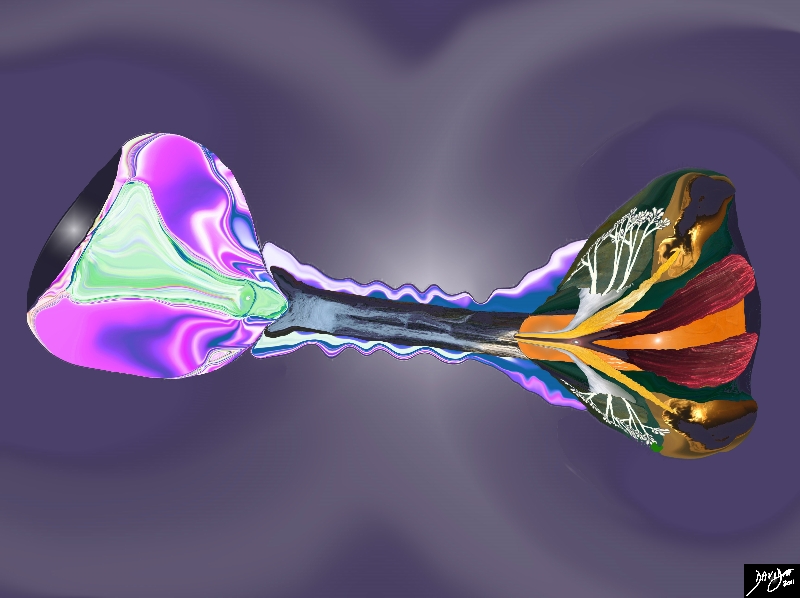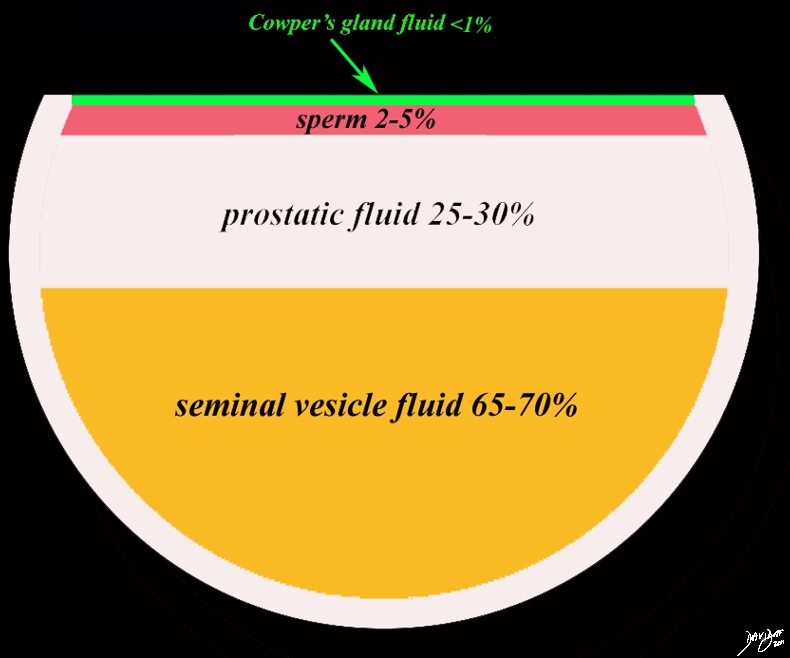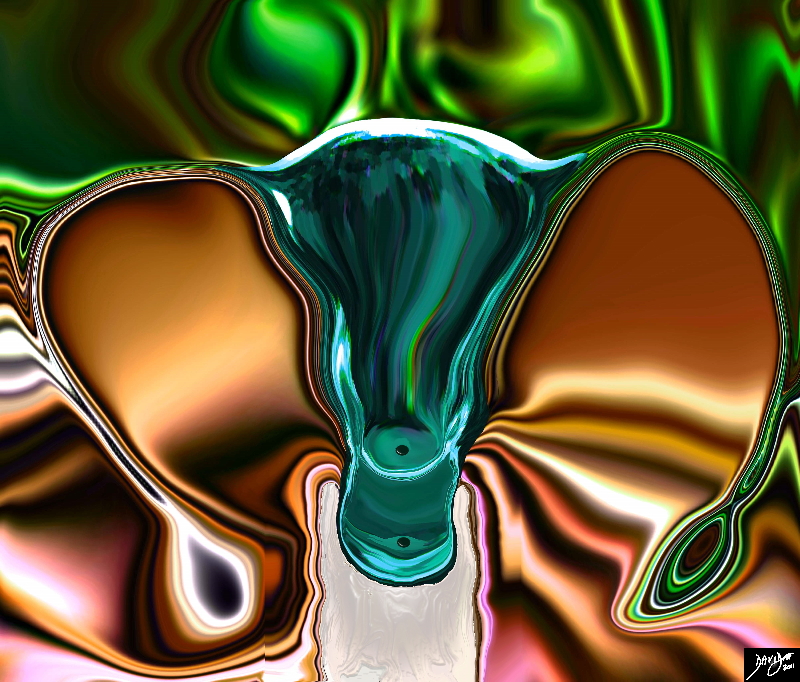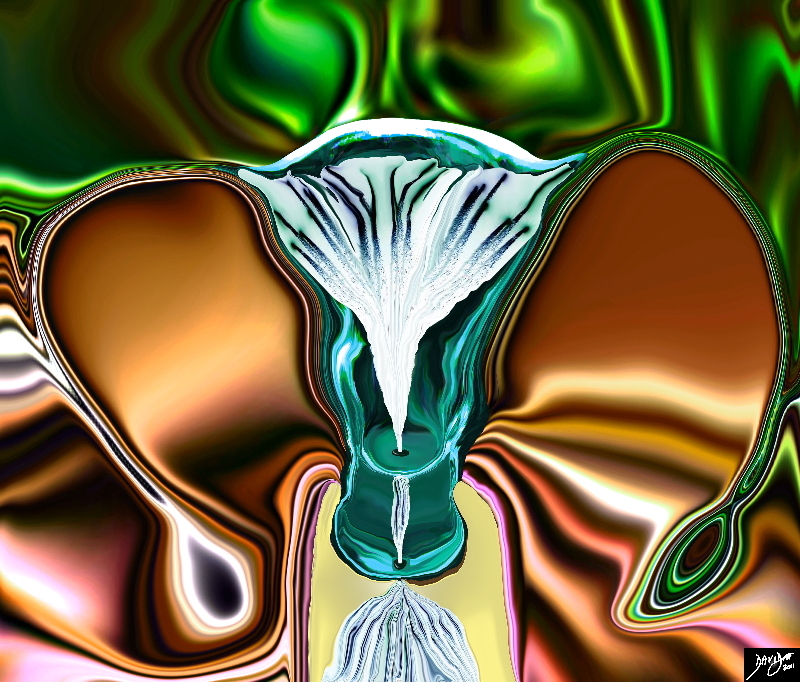The Common Vein Copyright 2010
Basic Principles: Receive, Process, and Export
|
Principles of the Prostate |
|
This diagram frames the underlying principles and approach to the prostate in this module – receive process and export Image Courtesy Ashley Davidoff MD Copyright 2010 99380b01.46.8s |
The prostate is present in all mammals and its function, though still not completely understood, has importance in reproductive physiology. The most obvious function is to participate in the production of semen, but it also has a function in the ejaculatory process by acting as a mechanical pump, and acts as a one way conduit for the semen by clamping off the internal sphincter and opening the external sphincter during ejaculation. Interestingly it also participates in the pleasurable feeling of the orgasm, with its female counterpart, the Skene’s glands which are purportedly considered the erogenous G spot that brings pleasure to the female during sexual intercourse. Skene’s glands lie lateral to the female urethra.
|
Love Potions Accumulate in the Prostatic Urethra Just Prior to the Opening of the Sluice Gates |
|
The prostatic urethra serves as the mixing pot for the components of semen by acting as the receptacle of secretions from the prostate itself, the seminal vesicles and the vas deferentia. This artistic rendition shows the region of the verumontanum which is the site where the mixing pot stands receiving sperm from the testes via the vas deferentia (red), the secretions of the seminal vesicles (orange) and the secretions of the prostate gland white). The last component contributed by the bulbourethral glands (Cowpers’s glands – green) joins the secretions in the penile urethra to form semen. Courtesy Ashley Davidoff MD Copyright 2011 All rights reserved 83101b17.2k.8s |
The process of ejaculation and the transport and life cycle of semen is a marvel and we will take you through this chronologically.
Show Time
The components of semen are continually produced and during intercourse the seminal vesicles, seminiferous tubules, and prostatic glands are overflowing with their products. The diagram below by da Vinci exemplifies coitus.
|
Copulation by da Vinci |
|
The diagram is a remarkable drawing by Leonardo da Vinci It shows a male figure in the full act of copulation. The resulting ejaculate consists of fluids from the prostate, seminal vesicles and sperm. da Vinci da Vinci 54961 |
|
Things Heat Up and Are Readied For Delivery |
|
In this diagram the function of the prostate is shown as a mysterious organ acting as a melting pot of the love potions. It depicts the “pot” receiving contributions from 3 sources – sperm from the testes, breathed into the pot by the alchemist, fluid from the seminal vesicles emanating from the crooked palms of the alchemist, and prostatic secretions entering the brewing pot from the side. Cowper’s glands (shocking pink) add a drop into the mix in the region of the membranous urethra to complete the formation of semen. This diagram has been used above but the “hotting up” just prior to ejaculation is depicted in the reds and oranges. Courtesy Ashley Davidoff MD 99655b08b05b03.8s |
As the climax is approached the three major organs that produce the semen are all revved up and in full production, and finally ejaculation takes place.
During ejaculation the anterior fibromuscular zone of the prostate plays its part by assisting in closing the internal sphincter with smooth muscle thus prevents the forward flow of urine into the ejaculate and preventing the ejaculate from going backward into the bladder. The anterior fibromuscular zone also assists in opening the external sphincter using the skeletal muscle allowing the gate to open for the semen to be released. Lastly by contractions of the fibromuscular layer in the central zone the prostate helps to expel the semen.
|
Opening of the Sluice Gates – Artistic Rendering |
|
The diagram reveals the process of ejaculation when the sluice gates open under sympathetic control and semen is transported from the prostatic urethra to the penile urethra and finally exiting with ecstasy through the meatus. The upper sphincter is closed and the lower sphincter is open. The smooth muscle of the central zone of the prostate participates in the ejaculation process by contracting forcing the semen into the urethra. The prostate and urethra are depicted as a wine glass with the prostate depicted in the cup and the penile urethra as the stem. Courtesy Ashley Davidoff MD Copyright 2011 All rights reserved 83101b29k.8s |
The prostate in addition participates at a higher level in that it enhances the pleasurable sensations during orgasm.
|
Communion and Delivery of Holy Water |
|
This is an artistic rendering of the prostate in action delivering the magical fluid to the front door of the female Image Courtesy Ashley Davidoff MD Copyright 2011 83101b26kc07.8s |
The initial ejaculate is a heterogeneous mixture. The first portion of the ejaculate, about 1-2% of it, is made up of secretions from the Cowper (bulbourethral) and Littre glands that lubricate the urethra and buffer any acidic urine than may be present in the urethra. The second portion derives from the prostate and contributes from 15% to 30% to the ejaculate. It is a milky white to gray in color. Thereafter sperm from the testes via the vas deferentia (2-5%) follow and, finally, the contribution of the seminal vesicles, which accounts for the majority of the ejaculate (65-70%), arrives. The normal PH of semen is between 7.05 and 7.8 and normal sperm count should be more than 20 million per mls and is usually closer to more than 40 million per ml and even up to 250 million per ml. It boggles the mind to think of the number of “hopefuls” looking for the one Miss Right, and only one of which will be successful.
|
Volume Ratios of the Components of Semen |
| The diagram reveals the components of semen which contains fluid from the seminal vesicles accounting for 65-70% of the volume, prostatic fluid – 25-30%, sperm 2-5%, and fluid from Cowper’s gland which represents less than 1% of the volume. Each ejaculate contains between .1-10mls (1-2 teaspoons) with an average of 3.5mls (Owen)
Courtesy Ashley Davidoff MD Copyright 2011 All rights reserved 99652b02pL.8s |
1-2ccs of prostatic fluid is secreted in the urine per day in the absence of ejaculation.
The vaginal environment is acidic (PH about 4), and as such is a protective environment for the vagina against bacteria. On the other hand sperm are also sensitive to the acid environment. Nature has solved this problem by creating a two step process in the safe delivery of sperm. The first step is the deliver the sperm in coagulated form and protected from the acid, and the second step is to liquefy the coagulated form and free the sperm into a safe environment.
Chemical Components of the Prostatic Secretion
The prostate gland produces and stores a fluid that has a high buffering capacity when mixed with other components of semen. The PH of semen is close to body PH and is used to buffer the acidity of the vagina ensuring a safer chemical environment for the sperm which survive longer and have greater motility within the environment of prostatic secretions. (Owen).
As the PH is buffered the chemical environment becomes safer for the sperm
The prostate is also responsible for the production of many other components that comprise semen. It is a milky fluid contains acid phosphatase, citric acid, inositol, calcium, zinc, and magnesium. Enzymes, such as proteases, esterases, phosphatases, prostate specific antigen, amylases, pepsinogen and hyaluronidase are also present.
The concentration of citric acid in prostatic secretion is the highest found in the body (Kandeel) by an order of 100 times. This latter fact adds one more mystery about the prostate. One hypothesis is that the citrate serves to chelate calcium and thus aids the PSA enzyme in liquefying the coagulated semen that initially forms and attaches itself to the cervix.
The presence of zinc from the secretion presumably is an antiseptic . When the semen initially enters the vagina it clots which glues the semen and trapped sperm to the cervix. The PSA enzyme will lyse this clot and releasing the sperm which will find their way into the uterus and then the Fallopian tube.
The semen coagulates due to a fibrinogen like agent secreted by the seminal vesicles. The semen is also sticky allowing it to become adherent to the cervix. The sperm needs temporary cocoon type protection from the acidic environment of the vagina. The sperm are housed in the coagulum and are nourished by other components of the semen eg fructose produced by the seminal vesicles.
|
Coagulated Ejaculate Adherent to the Cervix |
|
The diagram depicts the white creamy sticky and coagulated ejaculate adherent to the cervix. Once the acidic environment of the vagina is buffered, the ejaculate liquefies and the sperm can be released. Citric acid from the prostatic component of the secretion chelates calcium and assists the prostate specific antigen enzymes in liquefying the semen. Courtesy Ashley Davidoff MD Copyright 2011 46701b03.53ks01s04b.8s |
Following ejaculation and formation of the coagulated semen, between about 5-20 minutes is needed for liquefaction to occur that will allow the release of the sperm. This period allows the PH of the acidic vaginal environment to be buffered by the semen in order for the sperm survive.
Liquefaction occurs as a result of proteolytic enzymes within the prostatic secretion that include pepsinogen, amylase, hyaluronidase and prostate specific antigen. The citric aid as stated appears to assist the process by chelating calcium.
|
“Free At Last” |
|
The diagram depicts the liquefaction of the coagulated ejaculate now becoming a pale cream releasing the 40-250million sperm that have one mission in mind – the race to glory and fertilization of the ovum. With artistic license the diagram amplifies “free at last” and then the race, showing the sperm storming the gate of the external os of the cervix, – through the cervical canal and then into the wide open space of the endometrial canal and looking for the appropriate tiny opening of the Fallopian tubes where fertilization will finally take place. Courtesy Ashley Davidoff MD Copyright 2011 All rights reserved 46701b03.53ks10s03.8s |
The prostate is unique as an androgen-receptor expressing organ in that it remains sensitive to androgens throughout life. This occurs through a process of differential gene expression known as imprinting and may be of importance in the development of benign prostatic hyperplasia (BPH).

